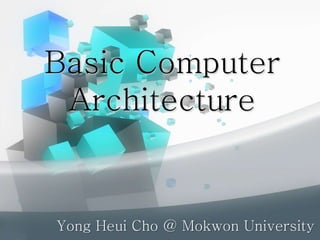
Basic Computer Architecture: An Introduction
- 1. Basic Computer Architecture Yong Heui Cho @ Mokwon University
- 2. 2 Basic Computer Design 1. History of Computers 2. Introduction to Arduino 3. Basic Computer Architecture 4. Combinational Logic Circuit
- 3. 3 Computer Components • Input/output units • Memory/storage units • CPU (Central Processing Unit)
- 4. 4 Motherboard Diagram • Northbridge – Connected to CPU in high speed • Southbridge – Connected in low speed • Bus – Related to “omnibus” – Communication system between components
- 10. 10 CPU: 3 Major Components • ALU (Arithmetic Logic Unit) – Performs calculations and comparisons (data changed) • CU (Control Unit): performs fetch/execute cycle – Functions: • Moves data to and from CPU registers and other hardware comp onents (no change in data) • Accesses program instructions and issues commands to the ALU – Subparts: • Memory management unit: supervises fetching instructions and d ata • I/O Interface: sometimes combined with memory management u nit as Bust Interface Unit • Registers – Example: Program Counter (PC) or instruction pointer determi nes next instruction for execution □ Courtesy to Basic Computer Architecture, slideshare.
- 12. 12 Concept of Registers • Small, permanent storage locations withi n the CPU used for a particular purpose • Manipulated directly by the CU • Wired for specific function • Size in bits or bytes (not MB like memor y) • Can hold data, an address or an instructi on □ Courtesy to Basic Computer Architecture, slideshare.
- 13. 13 Register Operations • Stores values from other locations (regist ers and memory) • Addition and subtraction • Shift or rotate data • Test contents for conditions such as zero or positive □ Courtesy to Basic Computer Architecture, slideshare.
- 14. 14 Registers in CPU • Program Counter (PC) register • Instruction Register (IR) • Status register: status, flags
- 15. 15 Cache Memory • Cache level – L1 cache: fastest and smallest – L2 cache: next fastest and smallest
- 16. 16 Operation of Memory • Each memory location has a unique addr ess • Address from an instruction is copied to the MAR (Memory Address Register) whi ch finds the location in memory • CPU determines if it is a store or retrieval • Transfer takes place between the MDR ( Memory Data Register) and memory • MDR is a two way register □ Courtesy to Basic Computer Architecture, slideshare.
- 17. 17 MAR, MDR, Memory Address Data □ Courtesy to Basic Computer Architecture, slideshare.
- 18. 18 MAR-MDR Example □ Courtesy to Basic Computer Architecture, slideshare.
- 19. 19 Individual Memory Cell □ Courtesy to Basic Computer Architecture, slideshare.
- 20. 20 Memory Capacity • Determined by two factors 1. Number of bits in the MAR • 2K where K = width of the register in bits 2. Size of the address portion of the instruction • 4 bits allows 16 locations • 8 bits allows 256 locations • 32 bits allows 4,294,967,296 or 4 GB • Important for performance – Insufficient memory can cause a processor to w ork at 50% below performance □ Courtesy to Basic Computer Architecture, slideshare.
- 21. 21 Random Access Memory • DRAM (Dynamic RAM) – Most common, cheap – Volatile: must be refreshed (recharged with pow er) 1000’s of times each second • SRAM (Static RAM) – Faster than DRAM and more expensive than DR AM – Volatile – Frequently small amount used in cache memory for high-speed access used □ Courtesy to Basic Computer Architecture, slideshare.
- 22. 22 Read Only Memory • Non-volatile memory to hold software th at is not expected to change over the life of the system • Magnetic core memory • EEPROM – Electrically Erasable Programmable ROM – Slower and less flexible than Flash ROM • Flash ROM – Faster than disks but more expensive – Uses • BIOS: initial boot instructions and diagnostics • Digital cameras □ Courtesy to Basic Computer Architecture, slideshare.
- 23. 23 CMOS Memory • CMOS (Complimentary Metal Oxide Semiconductor) TR (Transistor) – Low power consumption, cheap TR • BIOS (Basic I/O System) and system settings that users can change
- 24. 24 Arduino: 직렬 통신으로 문자 받기
- 25. 25 Arduino: 기계 엡실론 구하기
